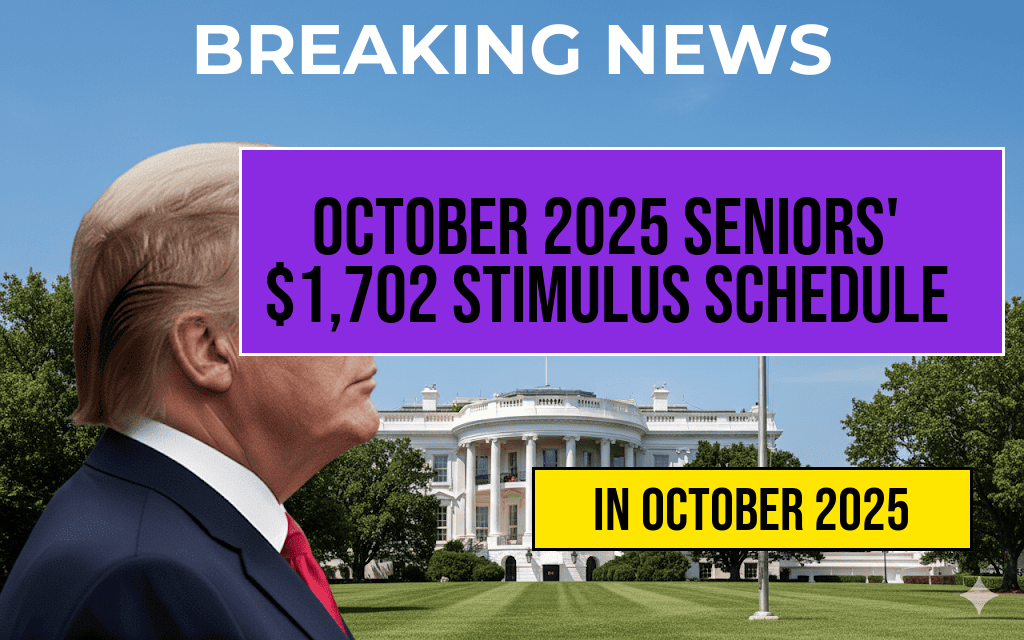In October 2025, eligible seniors across the United States will receive a one-time stimulus payment of $1,702 as part of a federal initiative aimed at providing financial relief. This payment is designed to assist older adults who are facing increasing living costs, particularly in the wake of recent economic challenges. The initiative, announced by the Department of Health and Human Services (HHS), has been met with a mixed response, reflecting both relief and skepticism among seniors regarding government support. The program is set to launch on October 1, 2025, with the funds expected to reach beneficiaries by the end of the month. The targeted demographic includes seniors who are receiving Social Security, Supplemental Security Income (SSI), or other forms of government assistance.
Payment Schedule
The distribution of the $1,702 stimulus payments will occur over several weeks, ensuring that funds are allocated efficiently. Below is the comprehensive schedule detailing when eligible seniors can expect to receive their payments:
| Week | Date | Payment Method |
|---|---|---|
| Week 1 | October 1-7, 2025 | Direct Deposit |
| Week 2 | October 8-14, 2025 | Checks Mailed |
| Week 3 | October 15-21, 2025 | Direct Deposit |
| Week 4 | October 22-31, 2025 | Checks Mailed |
Eligibility Criteria
To qualify for the $1,702 stimulus payment, seniors must meet specific eligibility criteria. The following factors will determine eligibility:
- Age: Applicants must be at least 65 years old.
- Income: Must have an annual income below the federal poverty line.
- Government Assistance: Must be receiving Social Security, SSI, or other designated government programs.
Interested seniors should verify their eligibility through the official Social Security Administration website or contact local agencies for assistance.
Impact on Seniors
The stimulus payments are expected to provide much-needed support to seniors, many of whom are grappling with rising healthcare costs and inflation. According to a recent study by the National Council on Aging, nearly 25% of older adults live on incomes that are insufficient to meet their basic needs. As a result, the $1,702 payment could significantly alleviate financial strain for many households.
Community Reactions
Responses to the stimulus announcement have varied. While many seniors express gratitude for the financial aid, some worry about the long-term implications of government dependency. Local advocacy groups are encouraging beneficiaries to use the funds wisely, emphasizing the importance of budgeting for essential expenses.
How to Access Information
Seniors can find more information about the stimulus payments through various platforms. The following resources are recommended:
Conclusion
The $1,702 stimulus payment represents a significant step towards supporting the elderly population in the United States during challenging economic times. As October approaches, eligible seniors are encouraged to stay informed about their payment status and utilize available resources to ensure they effectively manage their finances. The initiative underscores a commitment to addressing the unique challenges faced by older adults, ultimately enhancing their quality of life.
Frequently Asked Questions
What is the purpose of the $1,702 stimulus payments for seniors?
The $1,702 stimulus payments are designed to provide financial relief to seniors who may be struggling with rising costs and economic challenges in October 2025.
Who is eligible to receive the $1,702 stimulus payment?
Eligibility for the $1,702 stimulus payment typically includes seniors aged 65 and older, with specific income and residency requirements that may vary by state.
When will the $1,702 stimulus payments be distributed?
The distribution of the $1,702 stimulus payments is scheduled for various dates throughout October 2025, with specific timelines provided by local government agencies.
How will seniors receive their $1,702 stimulus payment?
Seniors can expect to receive their $1,702 stimulus payments via direct deposit, check, or prepaid debit cards, depending on their individual preferences and the methods established by the government.
What should seniors do if they do not receive their $1,702 payment?
If seniors do not receive their $1,702 stimulus payment, they should contact their local government office or the agency responsible for the distribution to inquire about their status and any necessary follow-up actions.

Leave a Reply